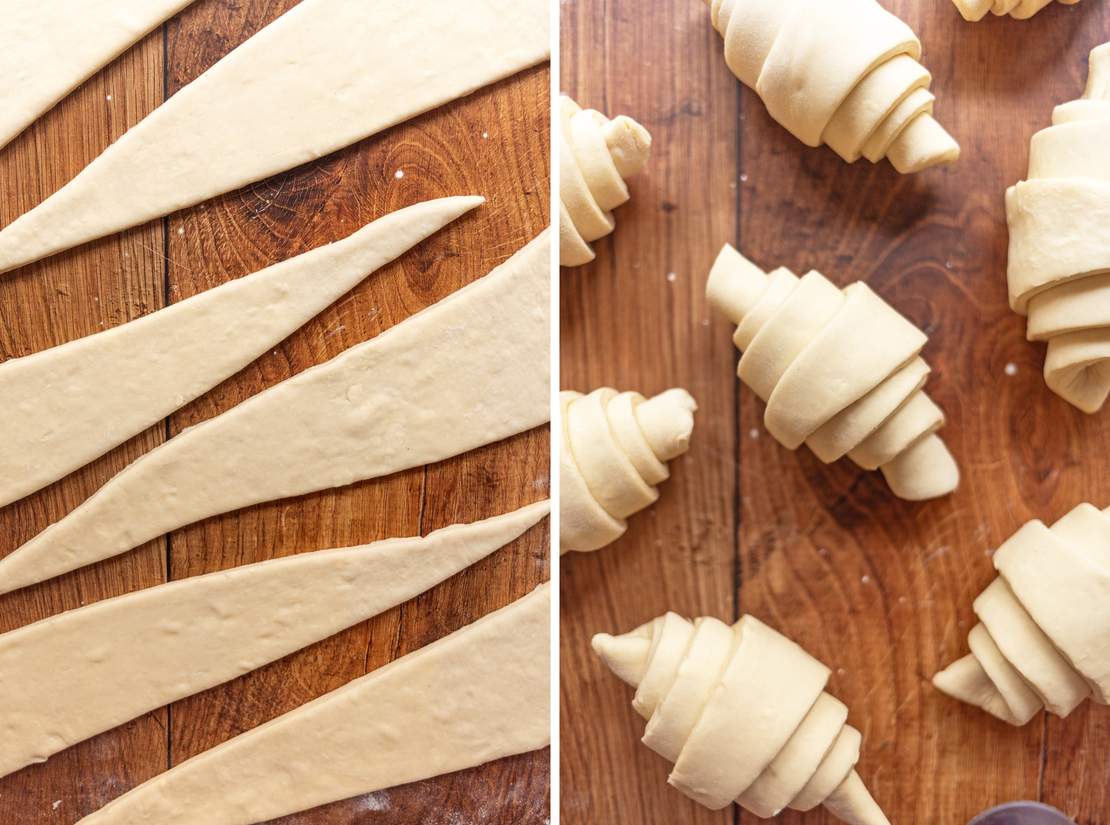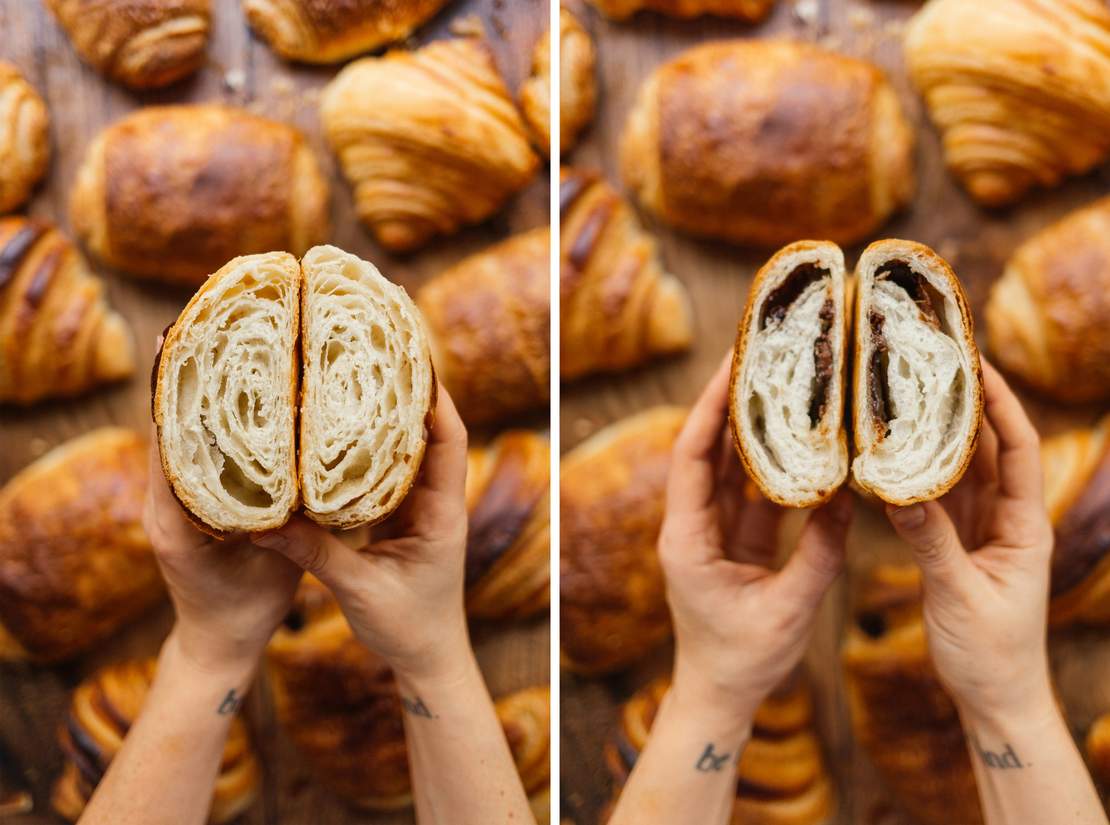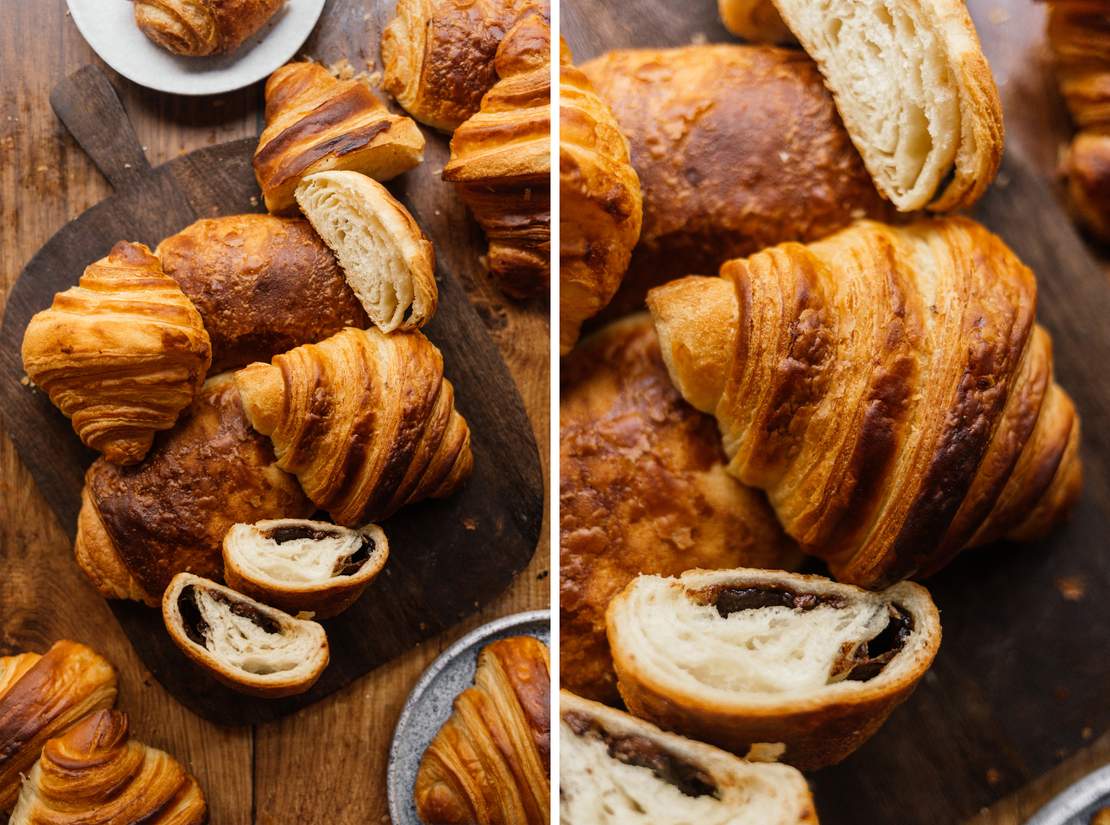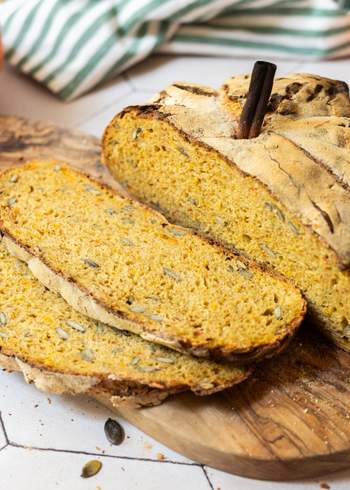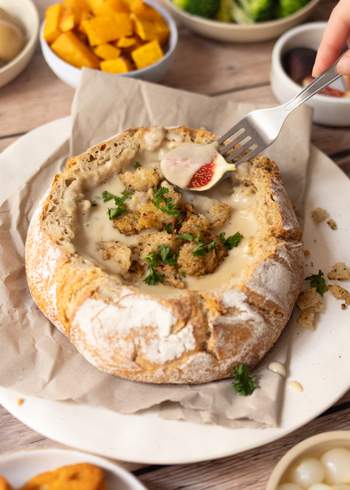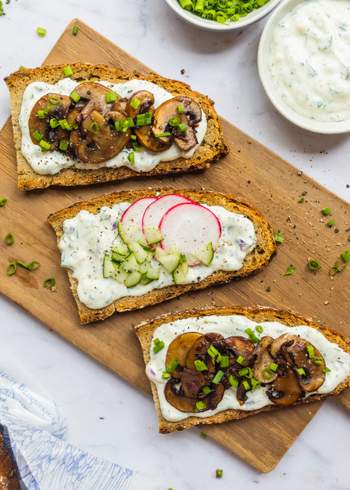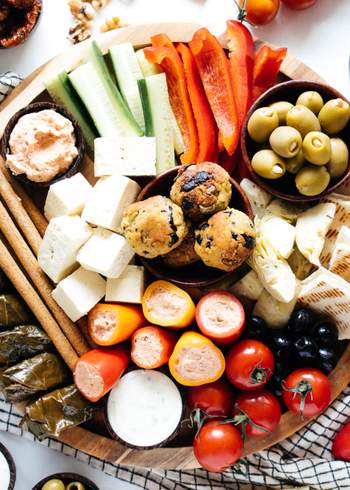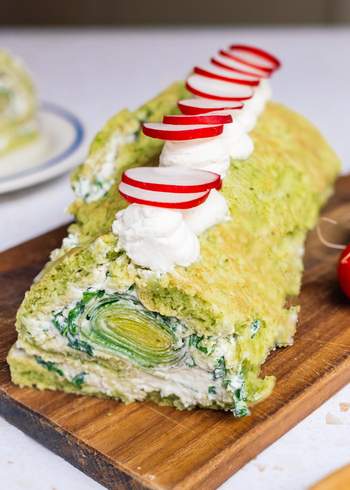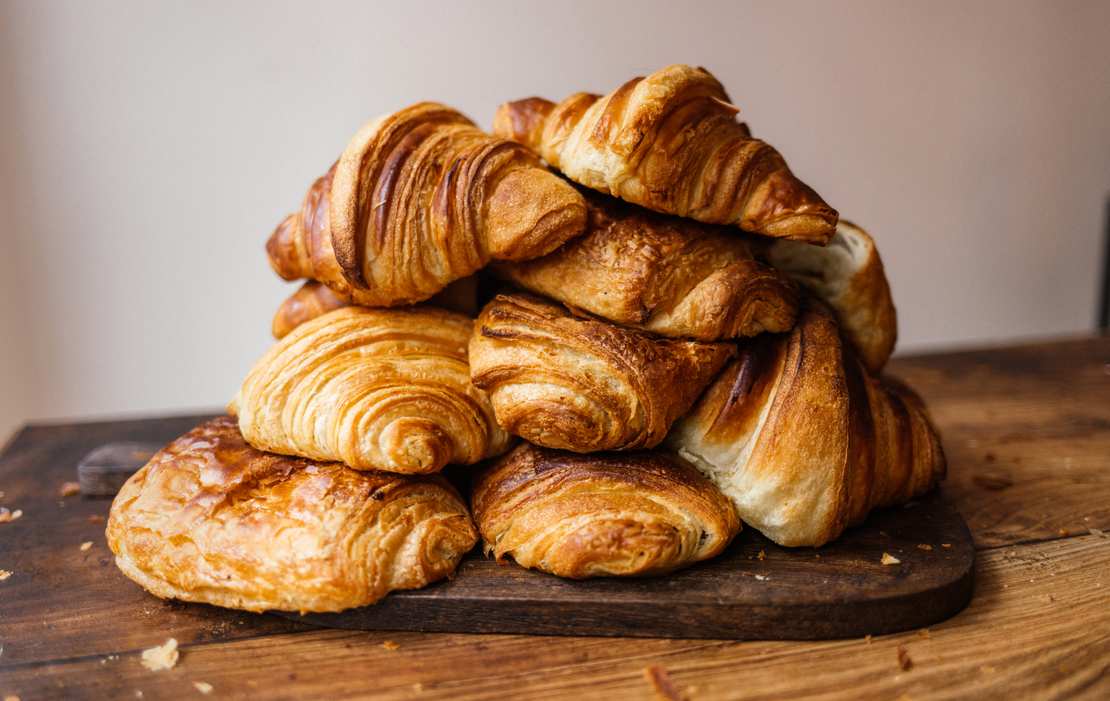
Homemade Vegan (Chocolate) Croissants
I have to confess: When we shared the upcoming new recipes as a team, I wasn't scared or upset when I got the vegan (chocolate) croissants – after all, I baked top-notch german pudding pretzels just a few months ago. They were so good that I could hardly believe I had baked them myself. Pudding pretzels and croissants have one thing in common: the puff pastry, including the butter layer, folding, ruler placement, and all the trimmings. That's why I thought I should „be done“ with the croissants pretty quickly. One test cooking, one photo, and that's it. But no, unfortunately, it wasn't like that after all.
Unfortunately, the dough turned out slightly differently from the custard filled pastry, as croissants have much more volume. The process is, therefore, the same, but the quantities didn't fit directly. My first attempts at croissants seemed solid at first but always ended up with a bread roll-like consistency. They didn't get big; you couldn't see the individual layers after baking, they didn't flake apart, and they didn't have any big air holes. But they were still delicious, of course.
And I would like to say that right up front to show you: Even if your homemade croissants don't turn out perfectly, don't be too hard on yourself or them. They may not always have the desired consistency, but they are usually delicious as they are. Just call them soft croissant rolls.
Back to the test kitchen: After my first „failed attempts,“ I fell into a bit of a croissant rabbit hole and ended up with helpful but somewhat intimidating recipes with over 20 steps. Nevertheless, her video also helped me better understand many of the steps and realize why some of them should not be skipped or shortened. I'll also say this upfront: unfortunately, a croissant is not a 15-minute cookie that you can bake in between.
Nevertheless, I tried out a few shortcuts and ended up with a recipe that is definitely more time-consuming than banana bread but can even be made in one day (if you want to eat croissants in the evening). For everyone else, I recommend splitting the recipe over two or even three days.
Bake croissants in three days (for breakfast or brunch)
Two days in advance: Prepare the butter and yeast dough (steps 1–4) so that both are in the fridge at the end.
One day before: Work the butter into the dough, fold the dough and shape the croissants (steps 5–10), then put them back in the fridge.
On the last day, leave the pre-formed croissants to rise and bake (steps 11–12). Depending on whether you want to eat them really early or rather for brunch, you need to get up early, take the pre-formed croissants out of the fridge and leave them to rise until they have become noticeably larger. To save a little time, you can leave them to rise in the oven, just switching on the light to get them a little warmer. However, the temperature should not exceed 40 °C / 100 °F. Then it's off to the really hot oven with them.
Bake croissants in two days (for breakfast or brunch)
One day in advance: In the morning, prepare the butter and yeast dough (steps 1–4) and leave to rest in the fridge for as long as possible. In the evening, work the butter into the dough, fold and shape the croissants (steps 5–10), and place them in the fridge.
On the second day: In the morning, leave the pre-formed croissants to rise and bake (steps 11–12). Again, you should get up early because the pre-formed croissants still need time to rise and can take up to 2 hours. To save some time, you can leave them to rise in the oven, just switching on the light to get them a little warmer. However, the temperature should not exceed 40 °C / 100 °F. They are then baked.
Bake croissants in one day
In the morning: Prepare the butter and yeast dough (steps 1–4) and leave to rest in the fridge for as long as possible. To speed things up, you can also put the butter in the freezer for a short time and then in the fridge.
In the late afternoon/evening, work the shortening into the dough, fold and shape the croissants, leave them to rise again, and then bake (steps 5–12). You can then eat them fresh from the oven.
The next day: get up relaxed in the morning, preheat the oven to 180 °C / 355 °F (convection heat) and put the baked croissants back in the oven for a few minutes so that they are warm and flaky again.
Finally, here are answers to a few questions you might be asking yourself.
1. What is a shortening, why do you need it and is it only possible with vegan butter?
Many recipes for homemade croissants only use (vegan) butter, but some use „shortening“ which you can buy or make yourself by adding a little flour to the vegan butter, mixing everything together, and only then shaping it and leaving it to cool again. The reason for this? Of course, the recipe also works without flour in the vegan butter, but the shortening has a few properties that will help you with your croissants. Of course, I'm not a trained baker and have trusted the written words of experienced bakers. This butter contains less water and is slightly easier to shape and fold because it becomes more elastic. It also has a higher melting point than normal butter.
2. Does the recipe also work with ready-made puff pastry?
You can, of course, go down the most convenient route and buy ready-made puff pastry or croissant dough, but this is often rolled out thinly and, therefore, although it contains yeast, does not rise very well in the oven. So you can get (chocolate) croissants, but they tend to be smaller and flatter.
3. Can I speed up the recipe?
Basically, you can always speed up the resting time of the dough by leaving it to rise at room temperature or by placing it in your oven and only switching on the light. In general, you should leave it to rise at a maximum of 40 °C / 100 °F. Another way to speed things up is to chill the vegan butter – instead of putting it in the fridge, you can put it in the freezer for a few minutes first and then in the fridge. However, you must make sure that it doesn't get too cold and hard. You can find all other tips directly under the respective steps in the text.

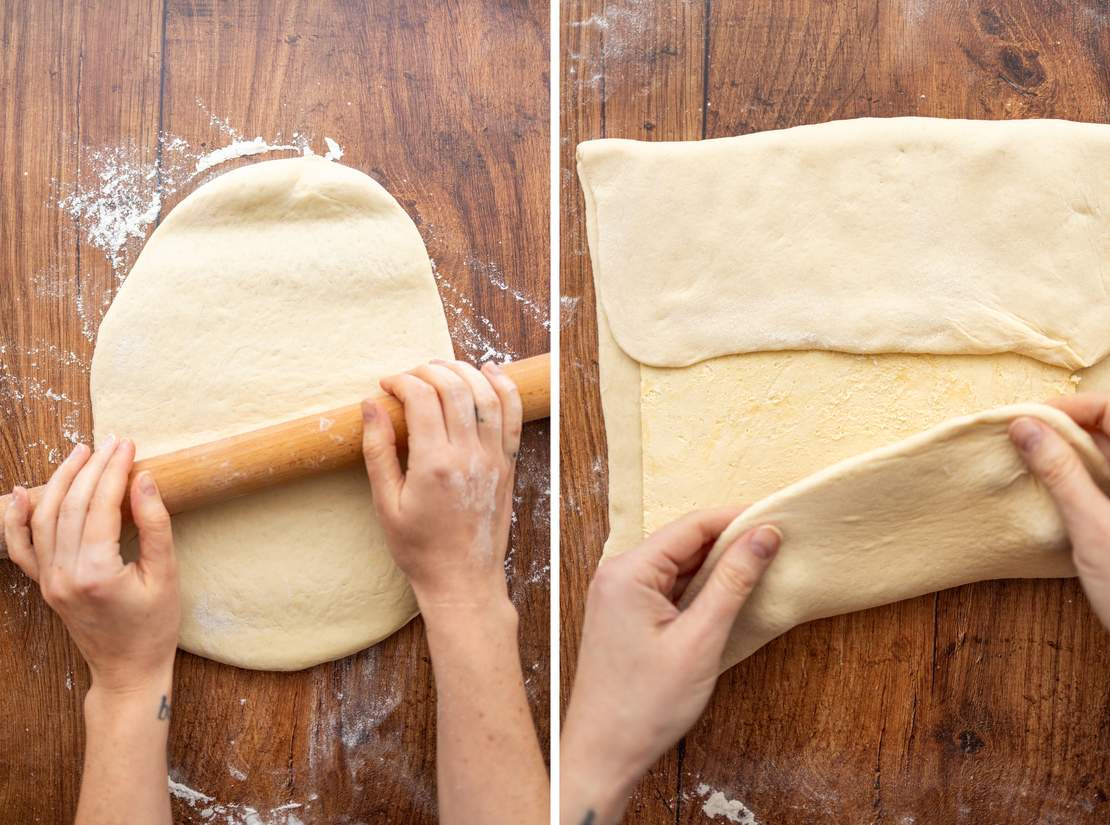

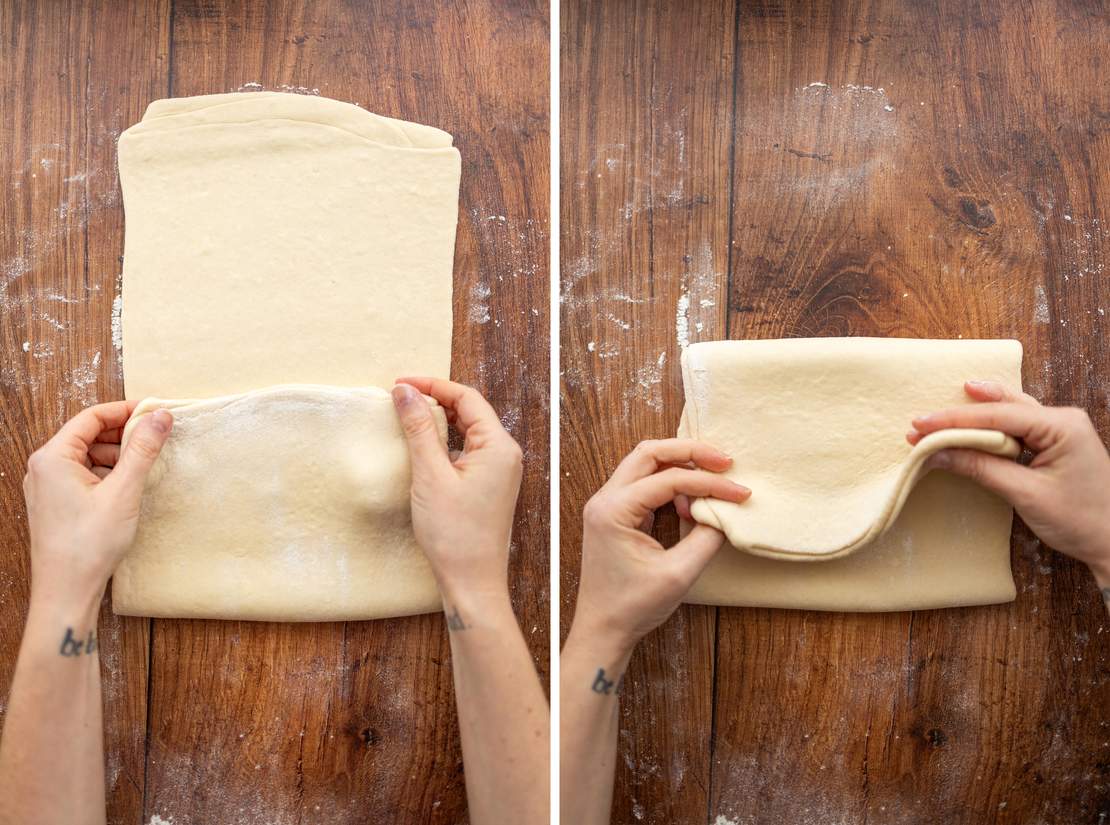

Homemade Vegan (Chocolate) Croissants
Ingredients
For the vegan shortening:
- 300 g (2.66 sticks) vegan butter (room temperature)
- 50 g (0.5 cup) wheat flour (type 405)
For the yeast dough:
- 500 g (4 cups) wheat flour (type 405)
- 7 g (1.5 tsp) active dry yeast
- 4 tbsp sugar
- 1 pinch of salt
- 275 ml (1 cup) warm water
- 50 g (0.5 stick) soft vegan butter
For the chocolate croissants:
- approx. 150 g (5.25 oz) vegan chocolate
For spreading:
- plant-based milk
- maple syrup
Instructions
- To make the shortening, mix the vegan butter with the flour and then roll it out into a square (approximately 20 x 20 centimeters / 7.5 x 7.5 inches) and wrap it in baking paper. Place the vegan butter in the fridge overnight until it is firmer but not frozen.
Tip: If you want to speed up this process because you want to eat the croissants on the same day, you can also put the shortening in the freezer first and then in the fridge. However, always make sure that it does not freeze and become too hard.
- For the yeast dough, mix the flour, dry yeast, sugar and salt in the bowl of a stand mixer. Then add warm water and soft vegan butter and knead everything until you have a smooth and supple dough that passes the so-called window test.
Tip: You can use the window test to determine whether the dough has been kneaded enough to make it elastic and form a good „gluten network.“ To do this, take a small piece of yeast dough and pull it apart on all sides. The dough should stretch well so that you can almost see through it (hence the name window test) and not tear apart. If it tears or you can't see through it, keep kneading the dough.
Shape the yeast dough into a ball and place it in a lightly greased bowl. Cover with a damp, clean kitchen towel and leave to rise at room temperature for 1–2 hours until the dough has doubled in volume.
After the rising time, shape the yeast dough into a thick rectangle – it should be about the same size as your shortening. Then wrap it up and put it in the fridge overnight. The reason for this is that the butter and dough should ideally be at the same temperature.
Tip: I have also found recipes that skip this step. However, there is a risk that the yeast dough will be too warm and soft, and the butter will run out more easily.
Then, roll out the yeast dough so that it is the same width as the shortening but twice as long (i.e., approximately 20 x 40 centimeters / 7.5 x 15.7 inches). Place the shortening on the bottom edge of the yeast dough, place the rest of the dough on top and press down lightly on all sides to seal the shortening inside.
Roll out the dough into a long rectangle using a rolling pin. Now, the folding begins. We start with a double fold. To do this, fold the outer short sides to the middle and then fold them on top of each other – like a book, so to speak. Viewed from the side, you will then have four layers.
Tip: If it's warm outside and you notice that the vegan butter is already getting too soft, wrap the dough in cling film and put it back in the fridge to firm up again. Depending on the temperature, this can take 15–60 minutes.
Then comes the easy tour. To do this, turn the folded yeast dough 90 degrees and roll it out again into a long rectangle. This time, fold the short sides of the dough over each other in thirds towards the middle – so if you look from the side, you should see three new layers. Wrap the dough in the cling film again and leave to rest in the fridge for 30–60 minutes so that the butter can firm up again.
Take the dough out of the fridge and roll it out this time. Flatten the outer sides with a pizza roller or a large knife.
If you want to bake croissants, first roll out the dough to approximately 45 x 35 centimeters (17.7 x 13.8 inches) and cut into wide strips – if you want particularly large croissants, the strips should be approximately 11 centimeters (4.3 inches) wide. For normal-sized croissants, around 8 centimeters (3 inches) is enough, and for small croissants, you can cut even shorter strips. Then, cut each strip diagonally into two triangles. Carefully roll up the dough triangles from the long side to the tip without applying pressure.
If you want to bake chocolate croissants, roll out the dough to approximately 40 x 36 centimeters / 15.7 x 14 inches. Cut the dough in half once so that you have two strips (approximately 40 cm x 18 cm / 15.7 x 7 inches), and then cut into ten rectangles of the same size (each approximately 8 x 18 cm / 3 x 7 inches). For each chocolate croissant, you need two „rows of chocolate“ that are as wide as your dough rectangles (i.e., 8 centimeters / 3 inches). Either you manage to really cut the chocolate into twenty long chocolate strips, or you simply break and cut them into larger pieces and place them next to each other. First, place one row of chocolate on the bottom edge of the short side of the dough and carefully roll the dough over it. Then, place the second row of chocolate where the rolled-up dough is. Continue to place the dough over the chocolate and shape it into a thick roll. Again, do not roll up with too much pressure so that the yeast dough remains fluffy.
Place the (chocolate) croissants on a lined baking sheet with plenty of space between them – it is best to use two baking trays. Mix the plant-based milk with the maple syrup and carefully brush the (chocolate) croissants with it. Cover again with a damp, clean kitchen towel and leave to rest at room temperature for approximately 1–2 hours until they have doubled in size.
Tip: I really recommend patience here, as the croissants should really increase in volume considerably before baking. Especially if you have had the dough in the fridge beforehand, it may take a while for the croissants to rise noticeably. But don't skip this step.
- In the meantime, preheat the oven to 200 °C / 390 °F (convection heat). Brush the (chocolate) croissants with the milk and maple syrup mixture again before baking. Then bake for about 10 minutes at 200 °C / 390 °F (convection heat), then reduce the temperature to 170 °C / 340 °F (convection heat) and bake the croissants for another 10–12 minutes until they are golden brown. Leave to cool after baking.
